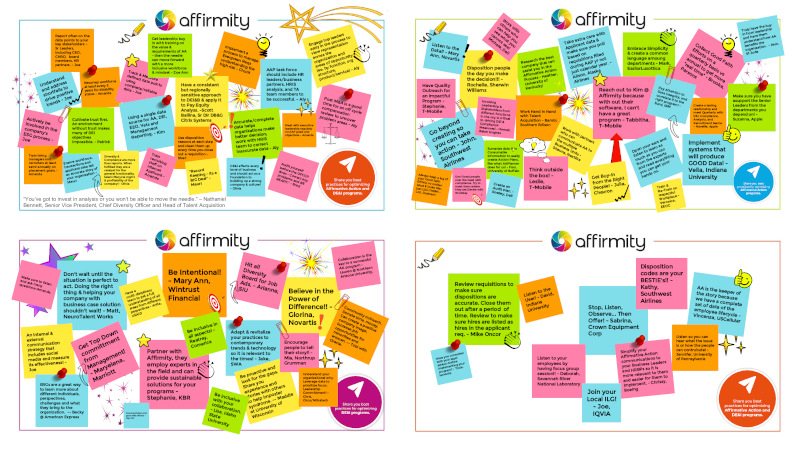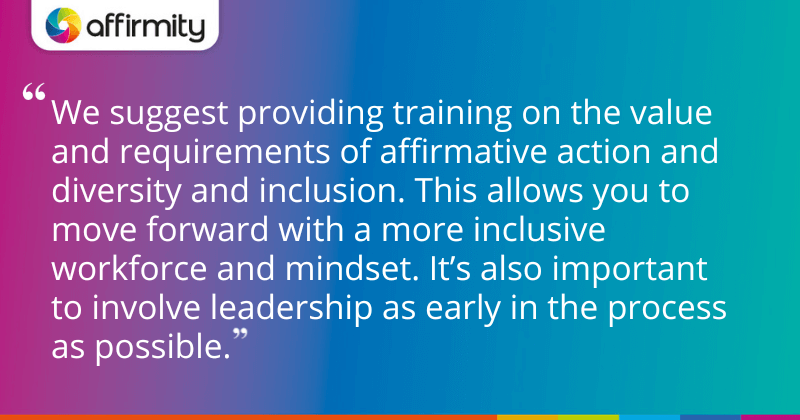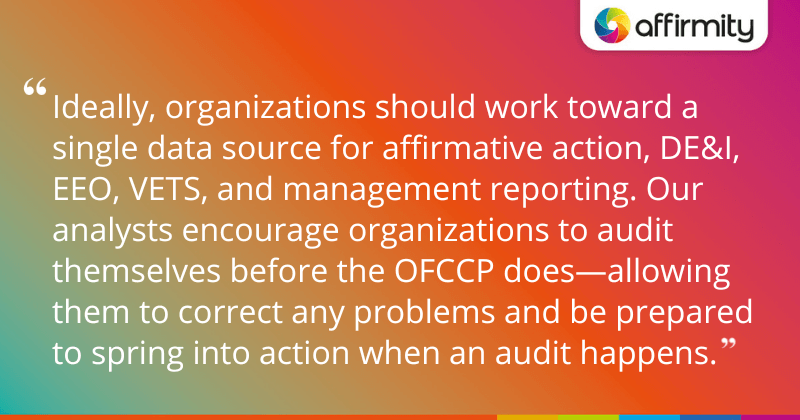Affirmity recently exhibited at the National Industry Liaison Group (NILG)’s national conference in Phoenix, Arizona, alongside other practitioners in the affirmative action, equal employment opportunity, and diversity, equity, and inclusion field. This year, we brought an interactive idea board—and received an impressive array of best practice tips worth sharing with a wider audience.
With a vision of making this year’s NILG 2023 booth more interactive, and of energizing the conversation on the show floor, we challenged visitors to share their best practices for optimizing affirmative action and DE&I programs. We received a fantastic response—over 70 messages, from practitioners across a full spectrum of organizations and industries. In this article, we’ve highlighted some of our favorites, and drawn out some of the common themes you’ll be able to factor into your own work!

Fig 1: An overview of the interactive idea board Affirmity brought to NILG 2023, showing off the many contributions we received.
1) Create a Taskforce and Find Allies in the Business
These first two tips provide an overall mission statement for a good chunk of the advice that was shared:
- “Have a multi-disciplinary team to get a full understanding of all areas from different perspectives.” – Anita, USAID
- “Collaboration is the key to a successful AA program.” – Lauren, Northern Arizona University.
We’ve often shared the importance of getting buy-in from the wider business, and it seems like this remains a key focus of many AAP and DE&I practitioners. Others named specific departments they felt were particularly important to bring on board:
- “Work hand-in-hand with talent acquisition.” – Bambi, Southern Edison.
- “Create a lasting relationship and meet quarterly with DE&I, compliance analysts, and recruitment teams.” – Navelle, Apple.
- “Have you consulted with your legal advisor before implementing your program?” – Tricia, Novartis.
Echoing and expanding on this advice, we recommend assembling a taskforce that includes HR leaders and business partners, as well as HRIS analysts, and talent acquisition team members. In particular, working with the HRIS team allows you to focus on correcting inaccurate and incomplete data.
MORE FROM THE BLOG | ‘4 Key Insights From the 2023-24 State of Pay Equity Report’
2) Engage Leaders and Stakeholders
Yet more advice focused specifically on winning over the right people from within the right teams, alongside engaging stakeholders from the top of the business:
- “Involving leadership and stakeholders from different functions in the organization is critical to driving DEI and compliance measures!” – Hemali, Baker Hughes.
- “Make sure you have support from senior leaders in the departments you depend on.” – Suzanna, Apple.
- “Get top-down commitment from management.” – Maryelena, Marriott.
Another comment stressed the importance of helping leadership understand the “why” of what you’re setting out to achieve, alongside the “what”:
- “Truly have buy-in from leadership and have them understand how AA benefits the organization.” – Pam, St Jude.
Practitioners can create this understanding in a number of ways. We suggest providing training on the value and requirements of affirmative action and diversity and inclusion. This allows you to move forward with a more inclusive workforce and mindset. It’s also important to involve leadership as early in the process as possible.

3) Work on How Programs Are Messaged Internally
Participants were keen to stress that once the right people are involved, it’s important to keep conversations simple and relevant to individual stakeholders—while being clear about what you’re trying to achieve, and how they can help:
- “Don’t beat people over the head with compliance. Try to meet them where they are.” – Denise, Workday
- “Embrace simplicity and create a common language among departments.” – Mark, EssilorLuxottica
- “Simplify your Affirmative Action communications to your Business Leaders and HRBPs so it’s more relevant to them and easier for them to implement.” – Chrissy, Boeing.
Further advice pointed to some of the best tactics for keeping the channels of communication open:
- “ERGs are a great way to learn more about different individuals, perspectives, challenges, and what they bring to the organization.” – Becky, American Express.
- “Train and re-train on respectful workplace.” – Veronica, EEOC.
LEARN ABOUT INTERNAL MESSAGING | ‘Getting the Business On Your Side: How to Talk About Affirmative Action Data With Everyone Else’
4) Undertake Outreach and Good Faith Efforts
A small but notable selection of notes centered on the importance of external communication, specifically outreach:
- “Donate both time and money toward community outreach. Create a positive company image, while increasing job opportunities for minorities and women.” – Tobi, Oracle.
- “Have quality outreach for an impactful program.” – Stephanie, T-Mobile.
Outreach, in the guise of good faith efforts, is a formal requirement of affirmative action planning. In recent years we’ve seen the OFCCP redouble its efforts to demand proof that federal contractors are making these efforts and subsequently evolving their approach. One note correctly stressed the importance of establishing a paper trail for this work:
- “Always keep a log of your good faith efforts. No matter what it looks like, just LOG THEM!” – Lori, Datavant.
5) Collect Comprehensive and Accurate Data
Getting into the finer detail, a number of practitioners share our focus on data integrity and comprehensive collection, providing pointers on applicant data specifically:
- “Take extra care with applicant data and make sure you pull based on requisitions filled during AAP year, not just calendar year.” – Alison, Alaska Airlines.
- “Implement systems that will produce GOOD data.” – Vella, Indiana University.
- “Review requisitions to make sure dispositions are accurate. Close them out after a period of time. Review to make sure hires are listed as hires in the applicant record.” – Mike, Oncor.
Record keeping is of course a big deal, and it’s critical to ensure that workforce transactions and applicant data tell an accurate story of your organization. Ideally, organizations should work toward having a single data source for affirmative action, DE&I, EEO, VETS, and management reporting. Overall, our analysts encourage organizations to audit themselves before the OFCCP does—allowing them to correct any problems and be prepared to spring into action when an audit happens.
FURTHER THOUGHTS ON DATA ACCURACY | ‘4 Signs That Your Applicant Data Won’t Pass an OFCCP Audit’

6) Consider These Tips on Timing
Though one of our looser themes, we felt it was worth highlighting some timing-related thoughts on dispositioning, good faith efforts, and general practice:
- “Disposition people the day you make the decision!” – Rochelle, Sherwing Williams.
- “Collect Good Faith Efforts on a quarterly basis versus annual to get more ‘real-time’” – Brooke Parsons.
- “Don’t wait until the situation is perfect to act. Doing the right thing and helping your company with a business case solution shouldn’t wait!” – Matt, NeuroTalent Works.
Timing is important in this line of work. It’s not only a matter of pouncing on tasks at the earliest opportunity—there are also certain messages that need to be reiterated with regularity. For example, we would encourage organizations to train hiring managers and recruiters at least semi-annually on placement goals.
Opportunities may also arise from corporate activity outside of your department—for example, post-merger/acquisition periods are a good time for an off-cycle compensation review to uncover problem areas. Always consider when your work is most likely to uncover meaningful insights, and when the business at large will be equipped to deal with them!
7) Strive for Clarity in Your Organizational Vision
Some of the contributions gestured towards the need to cultivate an organization-wide vision for programming, going beyond compliance alone:
- “Understand your organizational ‘why’.” – Chris, Circa (Mitratech).
- “Adapt and revitalize your practices to contemporary trends and technology so they’re relevant to the times!” – Jake, SWA.
Other advice from the board suggests one route to communicating this vision—encouraging the people who make up the organization to share their experiences:
- “Be proactive and look for the gaps. Share your experience and stories with others to help imposter syndrome.” – Maddie, University of Wisconsin.
- “Encourage people to tell their story!” – Mia, Northrup Grumman.
Ultimately, affirmative action, diversity, and inclusion work affects every level of the business. It therefore has a role to play in acting as a foundation for strong organizations and strong organizational cultures.
8) Get Third-Party Help
Finally, a number of contributions focused on the need for seeking external support with your programs:
- “Research the best company that can assist you in the affirmative action process.” – Heather, University of Kentucky.
- “Work with partners who can communicate affirmative action to the multiple business units.” – Shauna, NextEra.
- “Join your local ILG.” – Joe, IQVIA
If you need help with any area of affirmative action, diversity, equity, or inclusion, please contact our team today to find out more.
About the Author
Grace Mazar oversees marketing at Affirmity with direct responsibility for go-to-market strategy, product marketing and positioning, demand generation, and digital marketing. A seasoned B2B marketing leader who brings over 20 years of experience, Grace applies her deep industry knowledge and demonstrated outcomes-based marketing tactics to reach and influence targeted audiences and drive revenue.
